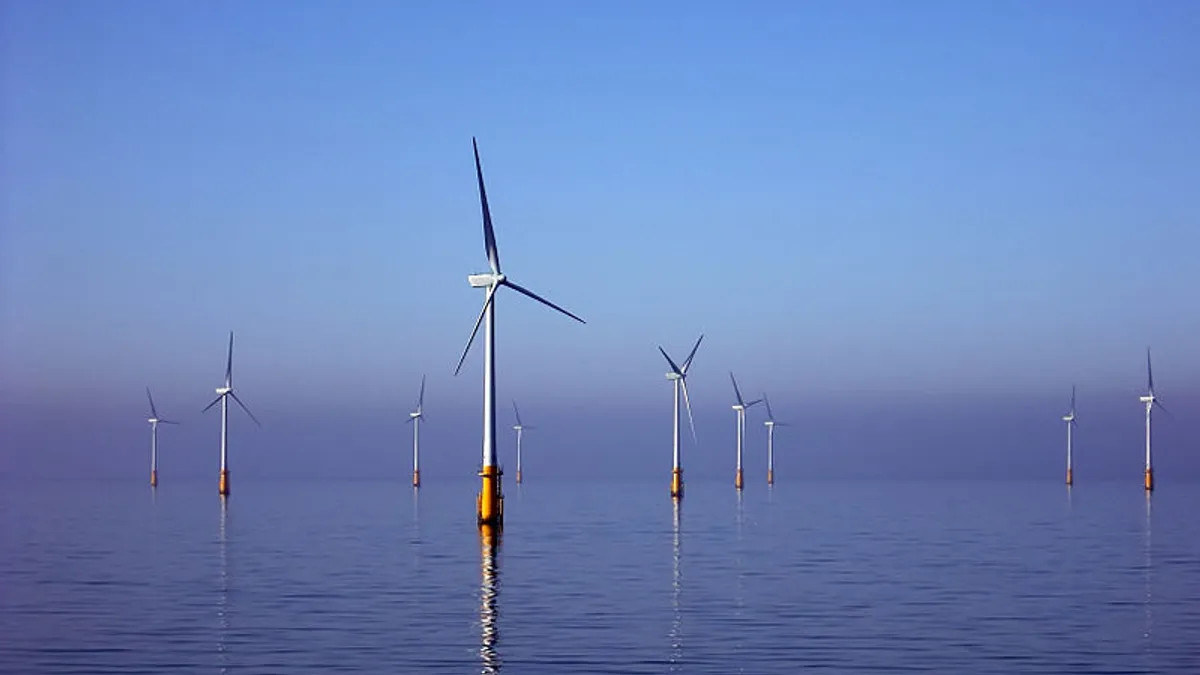Dive Brief:
- The Ohio Power Siting Board reversed itself Thursday and agreed in a unanimous vote to remove language from a construction permit the Board approved in May that would have required the nation's first freshwater wind farm to shut down turbines at night eight months out of the year to protect migrating birds and bats.
- Project developers called that provision a "poison pill" that made financing impossible and asked for reconsideration while 32 state lawmakers from northern Ohio publicly pressured the Board to reconsider. A draft version of Thursday's decision — circulated earlier in the week and introduced Thursday — had kept the overnight shutdown language.
- Siting Board member Mary Mertz, director of the Ohio Department of Natural Resources, offered an amendment before the vote on the draft proposal could be taken, removing the "poison pill" provisions, but allowing the full Power Siting Board as well as her agency to periodically review avian mortality rates rather than relying only on the Board's staff reviews.
Dive Insight:
The Lake Erie Energy Development Corp. (LEEDCo), developer of the 20.7 megawatt "IceBreaker" demonstration wind farm eight to 10 miles offshore from downtown Cleveland must now wait for the draft document to be amended and the Power Siting Board to reconvene in order to officially vote on the construction permit.
Samuel Randazzo, the top utility regulator in the state, said the extra meeting would be "expeditiously" convened, schedules permitting. Randazzo chairs the Power Siting Board and the Public Utilities Commission of Ohio.
LEEDCo's application has been before the Power Siting Board since 2016; and David Karpinski, president, said he was unexpectedly pleased with the outcome of Thursday's meeting. Reporting by cleveland.com earlier in the week, based on a copy obtained of the draft proposal, had convinced the company and lawmakers supporting the project that the Power Siting Board would keep the nighttime shutdowns in place, effectively killing the project.
The overnight shutdowns were initially proposed a year ago by the Power Siting Board's analysts, responding to concerns of birders, including the American Bird Conservancy of Washington, D.C. and the Black Swamp Bird Observatory in Ohio. The National Audubon Society also has had concerns and urged LEEDCo to show how it would mitigate environmental impacts.
LEEDCo and its consultants had agreed to perform monitoring studies at the site with advanced radar technology to detect birds and bats and to install collision technologies. The company agreed to adjust the pitch of the turbine blades, also known as feathering, if its detection system were to stop working properly. Additionally, the company agreed to immediately notify the Ohio Department of Natural Resources if more than 21 birds or bats were to collide with the turbines in 24 hours — at which point the agency could require additional mitigation measures.
The company signed a comprehensive agreement with the the Power Siting Board's staff, but the Power Siting Board included the overnight shutdowns anyway in its May order. Only after the Board voted did LEEDCO and its lawyers discover the provisions deep in the 100-page permit. The company asked the Board to reconsider.
The Power Siting Board's membership includes four lawmakers appointed by the state House and Senate as non-voting members. Three lawmakers attended Thursday's session and made it clear that they wanted the Board to approve the project, projected to be worth at least $250 million to the northern Ohio economy.
State Rep. Jeffrey Crossman and State Senator Sandra Williams, Democrats representing Greater Cleveland, aggressively questioned Board Chairman Randazzo both before and after Thursday's vote. Williams argued that by requiring overnight shutdowns during migration periods, neither LEEDCo nor the state would ever know whether the turbines are an actual threat to birds and bats.
Crossman, noting that the Power Siting Board's own staff and LEEDCo had negotiated the agreement requiring the company to install sophisticated radar and detection equipment, demanded repeatedly to know who inserted the nightly shutdown language into the permit approved in May and again during the past week. He suggested the Power Siting Board had "sandbagged" the developers.
Randazzo said such negotiated agreements in cases before the Power Siting Board or the Public Utilities Commission are merely recommendations and that the Power Siting Board "is entirely free to modify" such settlements. But Crossman asked again for the identity of the person or group that inserted overnight shutdowns into the permit.
When Crossman asked whether Randazzo had inserted the language, the chairman replied, "I believe I have answered your question. You choose to not believe that. The specific process is that content of the orders circulated for discussion purposes are prepared by the administrative law judge. That is the source of the language that's in the draft... They do their best to square what is in the order with the evidence and the law."
A third state lawmaker, Sen. Steve Wilson, a Republican representing southwest Ohio including parts of Greater Cincinnati, made it clear that the leadership of the GOP-dominated Senate supports wind development in the state as part of an "all of the above" energy position.
"It is our view that this Board should make no decision to preclude development of any particular category of resources in ways that detract from having a prudent diversity of resources," he said.
Correction: A previous version of this brief incorrectly described the steps LEEDCo and its consultants agreed to take to address the risks to birds and bats from the Icebreaker wind project. The story has been updated.













